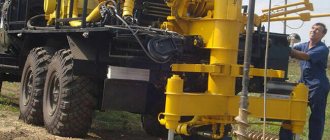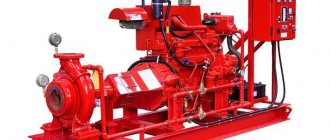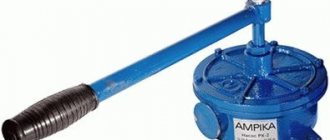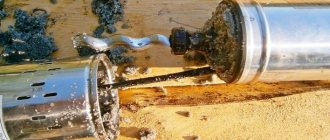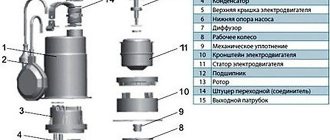Vacuum pumps have found their application on sewage disposal machines, the main task of which is cleaning storm sewers and pumping sewage from cesspools (toilets) and settling tanks, with the exception of explosive, aggressive and flammable substances.
In fact, pumping occurs using an intake hose, due to the vacuum created in the tank of the machine, which is created by a special vacuum pump, such as KO-503, 503v, 505, 514.
As a rule, such equipment is used by public utilities or industrial enterprises.
Type of vacuum equipment
- A low vacuum pump is used when pressure needs to be reduced. In addition, the equipment creates pressure, which is typical for low vacuum.
- High vacuum – used when operating a system with low pressure. This system usually includes two pumps connected in a row.
- Booster – installed in the middle of the high-vacuum and fore-vacuum pumps. This combination makes it possible to balance the outlet and inlet pressure of the above equipment.
- Forevacuum – used to maintain high vacuum. Thanks to this feature, the equipment is able to provide the specified pumping parameters.
- Preliminary vacuum - used in cases where it is necessary to reduce the pressure in the pumped volume from atmospheric to a point that allows another vacuum pump to operate.
Do you know which mini-cultivator to choose for your garden: manual or electric? And here you can find out the technical characteristics of tower cranes KB-403 and KB-100 3A.
What is a sewage disposal machine?
Since we are looking at pumps installed on sludge sucking machines, let us explain what a sewer pump is. This is a set of wheeled equipment that pumps out wastewater or sewage from cesspools, reservoirs, septic tanks, and settling tanks. After pumping out, the machine delivers the contents to disposal sites, where it unloads the sewage.
A typical sewer truck consists of the following main elements:
- storage tank. This is a steel cylindrical tank with a slight slope for ease of unloading;
- Vacuum pump;
- signaling and safety device. Its presence prevents the tank from overflowing and alerts the operator;
- receiving hatch with suction hose;
- pipeline control valve;
- additional electrical equipment.
Sludge pumping machine for sewer pumping KO 505A
The vacuum sewer pumping machine works on the following principle. All equipment is powered by a running engine. The suction hose is immersed in a container with the contents to be pumped out. The vacuum pump is turned on, creating a vacuum in the tank. The tank is filled with sewage. Once it is completely filled, a safety device is activated, shutting off the engine. After arriving at the unloading site, the tank is emptied by gravity or due to air pressure in the pump.
Advice: When calling a sewer truck to your site, ensure that it can easily travel to the pumping site.
Operating parameters
Among other parameters is the pumping speed, which determines the volume pumped out in a specific unit of time. In addition, the velocity is taken into account in a certain section at the pressure that was measured in this section.
The speed calculation is made in the input section of the operating equipment. The maximum starting pressure is the permissible pressure value at the inlet section of the equipment at which the pump can begin the operating cycle.
The maximum outlet pressure occurs at the outlet section of the equipment when the pump is still pumping out. The highest operating pressure is the permissible pressure in the pump inlet, thanks to which it maintains its nominal operating speed for a long time.
The maximum residual pressure is the pressure to which, indefinitely approaching, but never reaching it, the pressure in a standard test volume tends to with stably operating equipment.
The maximum productivity of equipment for liquid vapor determines the maximum amount of liquid vapor in weight units. The specified volume of liquid can be pumped out with a vacuum pump over a long period of time.
The maximum possible vapor pressure of a liquid is the maximum pressure measured at the inlet section of the pump. With the indicated pressure, gas ballast equipment can pump out liquid vapor for a long time.
The amount of pump compression determines the ratio of the volumes occupied by gases during the compression process in positive displacement pumps.
Purpose and operation of a vacuum pump
The vacuum pump for sewerage is designed to work in conjunction with other equipment installed on a sewer truck. With its help, the contents are pumped into a special tank, in which it is transported to the disposal site. The principle of operation of a vacuum pump is to create a vacuum in the working chamber in a short period of time . As soon as such a vacuum reaches the required value, the pumped-out substance (sewage, wastewater, steam) is sent to a storage tank. This type of pump is considered the most efficient in operation and safe for the environment.
Model KO-503
This pump is mounted on a sewer truck, which allows you to pump out sewage. For a diesel car, it is necessary to purchase equipment with right-hand rotary rotation.
Whereas a carburetor machine should be equipped with equipment with left-hand rotation.
To determine the direction of rotation, you need to look at the arrow shown on the body. In addition, if you look from the end side of the shaft, if it twists clockwise, this will mean that the torsion is right-handed, but if it’s the other way around, then it’s left-handed.
The equipment is created on the principle of capacitive vacuum air injection, as well as generating capacitive vacuum inside.
The tanks used are usually mounted on the GAZ-3309, 53 base.
In addition, the pump is used in PCF-3, PCF-4 tanks, which allows you to pump out or pump sewage inside. When using the equipment you must:
- guarantee the adjusted oil supply using the pump lubrication system;
- replace worn blades in a timely manner;
- Do not allow the pump to operate non-stop for more than 60 minutes.
The pump parameters allow it to operate in the temperature range from -20 to +40°C. Thanks to the vacuum created by the pump, the container is filled or emptied.
It should be noted that the pump body is made of cast iron. It is covered with caps with bearings that actually allow rotary rotation.
Blades are mounted in the rotor grooves. The pump body also has holes through which the equipment is lubricated.
In addition, an oil tank is attached to the frame, from where lubricant in the required volume, regulated by special screws, is supplied to lubricate the parts.
The marking KO-503 0214100 indicates that this is a pump with left-hand rotor torsion, while KO-503 0214100-02 indicates a pump with right-hand torsion.
Comparison of vacuum pumps KO 503, KO 505, KO 510, UVD 1000A. Which pump to choose?
Vacuum pump KO-503
Unfortunately, any equipment breaks down, and this also applies to sludge and vacuum machines. One of the most expensive parts of sanitation machines are vacuum pumps.
What is a CO vacuum pump? Why is it needed in a sewer truck? What parts does a cesspool pump consist of and how does it work? How not to make a mistake when choosing a vacuum pump? Which vacuum pump is better
for your car? We will try to answer these and a number of other questions in this article.
Comparison of pumps KO-503 and UVD10.000
The most popular pumps used on sludge and sewage disposal machines are: pump KO 503, pump KO 505, pump KO 510, pump ATC. Let's try to figure out what is the difference between these products from each other.
To do this, let’s compare the vacuum pumps that consumers use in their work and which are interchangeable. To begin with, I propose to carry out a comparative description of the ATC pump and the KO 503 pump.
In the minds of many people who are involved in the use of sludge and sewage disposal machines, these pumps are analogues.
Vacuum pump KO-503
1)
The vacuum pump KO 503 and the vacuum pump UVD are used mainly on vehicles on the GAZ 53, GAZ 3309, GAZ 3307 chassis.
2)
Capacity of vacuum pump KO 503 = 240.0 ± 20.6 cubic meters/hour, performance of vacuum pump ATC = 60 cubic meters/hour. As you can see, the productivity of the KO 503 pump is four times greater, and accordingly, pumping into the tank occurs several times faster.
Vacuum pump UVD10.000
3)
The KO 503 vacuum pump weighs more than the ATC vacuum pump (75 kg versus 48 kg).
4)
The difference in price, however, is small: KO 503 costs 15,260 rubles, the price of an air traffic control unit is 12,900 rubles. (prices for vacuum pumps are valid as of November 2018)
5)
Let's pay attention to such nuances as dimensions. And here the KO 503 pump is superior to the ATC pump:
Overall dimensions of vacuum pump KO 503, mm, no more:
length – 470
width – 280
height – 225
Overall dimensions of the vacuum pump ATC, mm, no more:
length – 366
width – 241
height – 432*
* Height is indicated with oiler.
6)
And yet, there is a category of consumers who, despite the superiority of the KO 503 pump over the ATC pump, have been using the ATC vacuum pump for many years.
And it's not just about force of habit, but also about the fact that it's reliable.
This is probably the main characteristic for this product. If the operating organization is not so interested in the speed of pumping into tanks, then they opt for an air traffic control pump.
Vacuum pump UVD
and vacuum pump
KO 503
you can purchase from the SpetsSnab Group of Companies. Vacuum pump UVD and vacuum pump KO 503 are available at the warehouse in Yekaterinburg.
Comparison of pumps KO-505 and KO-510
Now let's move on to the more powerful pumps KO 505 and KO 510. These products have a much wider range of applications. Vacuum pump KO 505 and vacuum pump KO 510 can be seen on special equipment on Kamaz, MAZ, Ural, ZIL chassis.
The KO 505 pump is more popular, since there are more sludge sucking and sewage disposal machines on the Kamaz chassis than on the MAZ, Ural, ZIL chassis.
And the KO 505 pump is considered “native” specifically for Kamaz, since it was initially installed on this vehicle at the manufacturing plants.
1)
The capacity of the vacuum pump KO is 510 360 cubic meters. per hour versus 310 cubic meters. per hour for the KO 505 vacuum pump. This is the main reason that if the consumer wants to increase the speed of pumping sewage into tanks, then instead of the KO 505 pump he purchases and installs the KO 510 pump.
Vacuum pump KO-510
2)
The nominal weight of the KO 510 pump is 130 kg, and that of the KO 505 vacuum pump is 120 kg. The difference is small, although the overall dimensions of the KO 510 exceed those of the KO 505 (length 700 mm versus 520 mm, width 310 mm versus 210 mm). The KO 510 gains an advantage in size due to the protective casing and fan, which the KO 505 lacks.
3)
Recently, there has been a tendency to use more powerful pumps on vehicles based on GAZ and Kamaz chassis. If previously only KO 503 vacuum pumps were installed on GAZ, now both KO 510 and KO 505 are purchased specifically for them.
All this is due to the fact that organizations that pump out sewage want to deal with each object faster, which will free up time for them to service a larger number of other objects, and therefore bring more income.
The average sewage injection time for machines on which KO 505 and KO 510 pumps are installed is 7-10 minutes.
Vacuum pump KO-505
4)
Due to the desire to make big profits, professional players in the market for sewage disposal services have recently been increasingly less likely to pay attention to vacuum pumps KO 503. And this despite the fact that the most popular equipment in this area is still GAZ (models GAZ 53, GAZ 3307, GAZ 3309).
Competition (it has recently intensified in this market due to the fact that people have realized that sewerage services are an interesting business) and quite feasible expenses at the first stage of work in the field of sewerage services (they basically take old cars, bring them to life and buy spare parts for KO) led to an increase in the number of participants in this market segment.
This is precisely what is associated with the reduction in the average cost of pumping sewage in the private sector and the desire of organizations providing sewage disposal services to gain an advantage over competitors due to higher speed of work.
This is the main reason for the growing popularity of the most powerful vacuum pumps on the domestic market - the KO 505 vacuum pump and the KO 510 vacuum pump.
Measuring the height of the vacuum pump KO-510
I would also like to add that in addition to choosing the right vacuum pump, for successful operation, it is necessary to operate it correctly and change spare parts and components in a timely manner.
So, before installing a vacuum pump on machines in operation, it is necessary to completely disassemble the pipeline to clean it.
Remember that if the pump breaks down due to the ingress of foreign particles from the pipeline, the manufacturers will not accept claims. A very important part of operating a vacuum pump is lubrication.
During the break-in period, manufacturers usually recommend increasing oil consumption by one and a half times.
Our company understands how important it is that the equipment does not stand idle, so you can buy from us from stock in Yekaterinburg, Ufa, Tyumen not only vacuum pumps for sewage disposal machines, but also spare parts for pumps, as well as components for them.
Pump operation
The process of using the pump requires compliance with certain conditions. In particular, it is necessary:
- keep the pump clean;
- carry out systematic flushing of the lubrication system, while filling it exclusively with purified oil;
- control oil consumption. The basic operating mode of the equipment requires an average of 90 g/hour.
Attention! The use of processed oils is prohibited. Non-stop operation of pumping equipment for more than 60 minutes is not allowed!
Principle of operation
A vacuum pump for sewerage is used to work together with other equipment that is equipped with a sewer truck . With its help, the contents begin to be pumped into a special tank, after which it is delivered to the place of its disposal.
The principle of operation of a vacuum pump is that a vacuum is created in the working chamber in a fairly short period of time. When such a vacuum reaches the required value, the pumped substance (wastewater, sewage, steam) begins to flow into the storage tank. This type of equipment is recognized as the most effective for such work.
Equipment properties
The list of main properties includes the following:
- power consumption – 6 kW;
- output – 240 m³/h;
- indicated number of revolutions – 1450 rpm;
- direction of rotor torsion – left, right;
- maximum vacuum – 0.085 MPa;
- ultimate compression – 0.06 MPa;
- maximum temperature conditions of the equipment – 80 °C;
- efficiency factor – 0.8-0.9;
- weight – 90 kg.
Dimensions:
- length – 47 cm;
- width – 28 cm;
- height – 22.5 cm.
Cost - 12 thousand rubles.
Possible faults
Possible malfunctions may include the following:
- tight rotary rotation;
- drop in throughput;
- knocking on the pump;
- case overheating;
- interruptions in oil supply;
- low pump vacuum.
There are several main reasons that lead to malfunctions.
Stiff rotor rotation occurs due to inaccurate assembly of the pump. A drop in throughput occurs due to worn out or dirty rotor blades.
A knock in the pump indicates that the bearings are worn out, the blades are sunken, the inner side of the body has been subjected to mechanical impact from blades up to 0.2 cm deep, while the standard height of the blades is 3.7 cm.
Overheating of the housing occurs due to lack of lubrication or contamination of the pumping unit.
Interruptions in oil supply , as a rule, indicate that air is being sucked into the connecting fasteners or dirt has entered.
A weak pump vacuum occurs when the tightness of the connecting fasteners is weakened, the blades sink, and the rotor rubs against the pump cover.
Methods to eliminate the above reasons may be as follows:
- with tight rotary rotation, the pump must be disassembled, washed and reassembled;
- the drop in throughput can be eliminated by replacing worn parts; in case of jamming, wash the parts;
- if a knock is detected in the pump, you need to replace the bearings, blades or casing;
- overheating of the housing indicates the need to fill the system with lubricant, disassemble the equipment, wash parts, clean the pipeline;
- if there are interruptions in the oil supply, tighten the connecting fasteners and bleed the dropper with air;
- in the case of weak pump vacuum, you need to tighten the connecting fasteners, remove the rotor and wash the parts, check the height of the blades.
Vacuum pump used for pumping out sewerage
If the site has an autonomous sewer system, it must be cleaned regularly. Failure to carry out this procedure in a timely manner leads to the fact that sanitary conditions on the site begin to deteriorate, and the cesspool or septic tank overflows. Subsequently, it will be much more difficult to maintain the sewer. To quickly and effectively pump out sewage, you should call a sewer truck, which is equipped with all the necessary equipment. The main element that is involved in the pumping process is the vacuum pump. With its help, the machine is able to clean the drainage structure in a few minutes.
Pump KO-505A
This pump serves to generate capacitive air injection and excess intracapacitive pressure. The equipment is mounted on the basis of ZIL, MAZ, KAMAZ, URAL.
The operating temperature of the KO-505 pump is from -20 to +40 °C. Filling and emptying of containers occurs due to the discharge of the pump.
The frame of the pump is made of cast iron, which is closed using lids. These covers contain bearings, due to which rotary rotation occurs.
The rotor grooves contain built-in textolite blades. The pump is also equipped with a lubrication system, which ensures forced lubrication of the equipment, so before starting operation it is necessary to adjust the oil flow.
Pump parameters
The list of main properties includes the following:
- power consumption – 9 kW;
- output – 310 m³/h;
- indicated number of revolutions – 1150 rpm;
- direction of rotor torsion – left, right;
- maximum vacuum – 0.085 MPa;
- ultimate compression – 0.06 MPa;
- maximum temperature conditions of the equipment – 80 °C;
- efficiency factor – 0.8-0.9;
- weight – 110 kg;
Dimensions:
- length – 52 cm;
- width – 30 cm;
- height – 29 cm;
Cost – 12 thousand 900 rubles.
Vacuum pump for sewer truck (vacuum truck)
One of the greatest achievements of mankind is sewerage, thanks to which people no longer suffer from plague and other diseases caused by waste products.
But it happens that the sewer becomes clogged. It is cleaned by the housing and communal services using a sewage disposal (scalp) machine.
How does a sewer truck work?
It is a vehicle based on KAMAZ, GAZ, ZIL, URAL and other trucks. The main difference from other machines is the presence of a vacuum cleaner, a special tank on the body into which waste products are pumped under the action of the apparatus.
Vacuum truck based on GAZelle vehicle
But what kind of unit is there? You can’t put an ordinary circular one there; it will immediately become clogged, because the water in the sewer is full of various dirt. We need a device that does not interact directly with water. And this is what the vacuum pump became.
Principle of operation
The vacuum pump for a sewer truck is installed inside the sewer truck. It pumps air out of the tank and, under the action of vacuum forces, water from the sewer is pumped into it. The pump allows you not to interact directly with water; all of it passes through the hose.
To withstand the pressure, the sewer tank is made of durable material that can withstand the air pressure from the outside. But there are different devices for different purposes.
Water of one degree of contamination requires one pressure, and another - another. In addition, if vacuum pressure is suddenly created, the equipment may malfunction.
You must first prepare the environment using special equipment.
There are quite a few types of pumps for sewer trucks.
Varieties
There are the following types of vacuum pumps, divided according to the degree of vacuum pressure:
- low vacuum;
- high vacuum;
- booster;
- Forevacuum
A low-vacuum pump, as the name implies, creates a low-pressure vacuum. It is enough to suck out water and dirt from the sewer. Such units are the most popular on sewage disposal machines. Create a pressure of about 1 Torr.
Vacuum pump kit for sewer truck
High vacuum pumps create high pressure. It is needed for pumping high-density liquids that low-vacuum devices cannot handle.
Most often used in metallurgy and the chemical industry. In metallurgy, they can pump hot liquid metal; in the chemical industry, they can pump gases and liquids of high density.
High-vacuum units are usually not used for stool washing machines.
Booster pumps are the most powerful vacuum units. They create more pressure than high-vacuum ones. They are needed where the power of previous types of devices is not enough. Usually works in tandem with the latter.
Forevacuum pumps (pre-discharge) - allow other pumps to start working, creating a deep vacuum.
If too high a pressure is created, switching between pumps can damage the next device in the pressure generation circuit. To avoid this, reduce the pressure.
Typically used in conjunction with high vacuum and booster pumps. It is not used for stool washing machines; there is no need for such a high pressure.
High pressure vacuum units are usually used in a system with other pumps for greater efficiency.
Division of pumps according to operating principle:
- mechanical;
- magnetic discharge;
- jet;
- sorption;
- cryogenic.
Mechanical units are used on sewage disposal machines. The remaining devices are simply not profitable to use; they are designed to work in laboratory conditions, and there is no need for them. The power of mechanical pumps is enough.
The operating principle of such a device is simple. The motor moves the pump, which pumps out the air. Nothing complicated. There is one caveat: for machines with different engines, pumps with different rotor rotations are used.
For stable operation of the pump, a diesel car must have a vacuum pump with a rotor that rotates to the right. An example of such a car is GAZ 3309.
For cars with a carburetor engine, a pump with left rotation of the rotor is used.
Equipment for the vacuum cleaner machine
Popular models
Vacuum pumps for sewer trucks have been used since the 1930s. During this time, these devices have come a long way from the simplest to the most modern. Today, the following models have stood out, tested in practice:
- vacuum KO-503;
- vacuum KO-505A;
- vacuum KO-510.
Model KO-503
Standard device, used on sewer trucks since the mid-1950s. Tested by time. The rotor of the device rotates to the right. Installed on GAZ-53, GAZ-3307 and GAZ-3309. The body is made of cast iron, which can withstand the vacuum pressure created by the pump itself.
Specifications:
- motor speed: 1500 rpm;
- productivity: 250 cubic meters per hour;
- maximum vacuum pressure: 6 nPa;
- weight: 80 kg;
- dimensions: 48x27x23 cm.
The cost of KO-503 is about 12 thousand rubles.
Model KO-505A
Improved model KO-503 with rotor rotation to the left. Installed on vehicles with a carburetor engine, such as KAMAZ, ZIL or URAL. Performance is higher than the previous model.
However, the pressure remained at the same level, which is not surprising. High pressure is not required to pump waste out of the sewer. This model places greater emphasis on personnel safety than the first.
Pump for sewer truck KO-505A
Specifications:
- motor speed: 1200 rpm;
- productivity: 320 cubic meters per hour;
- maximum vacuum pressure: 6 nPa;
- weight: 110 kg;
- dimensions: 52x30x29 cm.
The cost of KO-505A is about 13 thousand rubles.
Model KO-510
The most modern model of a vacuum pump with a mechanical type of operation. A distinctive feature is the ability to rotate the rotor both to the right and to the left.
This allows the unit to be installed on cars with any type of engine. However, the pumps in the pump are individual for right-hand and left-hand rotation of the rotor.
The pump performance is higher than other previous models. Maximum pressure at the same level. Slightly improved efficiency.
Specifications:
- motor speed: 1500 rpm;
- productivity: 370 cubic meters per hour;
- maximum vacuum pressure: 6 nPa;
- weight: 125 kg;
- dimensions: 67x31x34 cm.
The cost of KO-510 is about 15 thousand rubles.
The process of pumping out liquid using a sewer machine
This type of device is the most popular today and is used on almost all sewage disposal machines in large cities.
Operating rules
How to operate a pump on a sewer truck:
- Check the condition of the device. Everything must be connected and working properly;
- Lower the hose through which waste will be pumped into the sewer;
- Open the oil cup valve to supply oil;
- Open the valve that leads to the sleeve;
- Turn on the unit;
- After finishing the work, do everything in reverse order.
Tips for use
- select the right type of pump for a specific job;
- a very important component of proper operation is the coincidence of the side of rotation of the rotor with the type of engine;
- the unit should not be operated for more than an hour, as it gets very hot during operation;
- Carry out maintenance on time. This will greatly extend the service life;
- Make sure that the parts are lubricated at all times. The oil should be replaced regularly with clean oil;
- the pump pump should always be clean;
- The pump assembly must always be completed completely. Otherwise, serious damage may occur;
- average oil consumption – 80 grams per hour;
- Manufacturers indicate the direction of rotation of the rotor on the pump body;
- Connect the device to the system correctly to avoid damage.
Drum type sewer cleaning machine
Precautionary measures
- Do not touch the vacuum pump during operation! It gets very hot.
- Do not touch the device during operation. It is full of moving parts that are dangerous.
- Check grounding.
The device operates on electricity and if there is no grounding, there is a high probability of electric shock. - Noise from the operating unit may cause hearing damage. Use protective equipment.
- Use protective masks.
The vacuum pump may release harmful substances such as oil mist into the air. - Vibration from the operation of the device can cause various diseases.
Vacuum pumps are used in situations where direct interaction with the transfused substance is undesirable.
Such situations include sewer cleaning, work at a metallurgical or chemical plant.
Vacuum pumps that create low pressure are also used on sewer cleaning machines. High pressure is not necessary when working with sewerage. With the right choice of pump and proper operation, the devices will last a long time.
page » Pumps
Pump KO-510
The pump of this brand is suitable for machines with left-hand and right-hand rotation such as KO-510, 520, 523. In addition, such pumps are mounted on the basis of GAZ, ZIL, KAMAZ, MAZ, URAL.
This combination allows for manipulations with capacitive compression at operating temperatures from -20 to +40 °C. The arrow shown on the body makes it possible to determine the rotation of the pump.
The operating principle of the equipment is still based on the injection of air, as well as the generation of a capacitive vacuum inside. This is how sewage is dumped and pumped inside.
Two marking types of pumping equipment are standardly produced: KO-510 0216000-04 – right-hand torsion pump, and KO-510 0216000-05 – left-hand torsion pump.
Using a vacuum pump for a sewer machine
Vacuum pumps have found their application on sewage disposal machines, the main task of which is cleaning storm sewers and pumping sewage from cesspools (toilets) and settling tanks, with the exception of explosive, aggressive and flammable substances.
In fact, pumping occurs using an intake hose, due to the vacuum created in the tank of the machine, which is created by a special vacuum pump, such as KO-503, 503v, 505, 514.
As a rule, such equipment is used by public utilities or industrial enterprises.
Models of sewer trucks on GAZ chassis
Several models of sewer trucks have been created based on GAZ vehicles:
Machine KO-503V-2
The base chassis of the model is GAZ 3309. When the tank is filled, the chassis signal turns on automatically.
This is what the GAZ KO-503V-2 vacuum truck looks like
The design includes a long suction hose (6 meters) and uses a modernized vacuum pump. The car has the following technical characteristics:
- Tank capacity – 3.75 cubic meters. m;
- Pump capacity – 240 m3/h;
- The weight of a fully loaded car is 8.2 tons;
- Machine length – 7 m;
- Width – 2.2 m;
- Height – 2.6 m;
- The maximum depth of the container to be cleaned is 4 m;
- The average time to fill a barrel is from 3 to 6 minutes.
Types of sewage disposal equipment
At the dawn of the development of sewage disposal equipment, two model ranges of special equipment were sold. The first group included machines that carried out suction using the collector method, that is, due to the collector motor. The second version of special equipment is a built-in vacuum pump, which a little later was recognized as technologically advanced and rational. In the municipal sector, sanitary standards for sewage disposal machines were perfectly implemented using the implemented vacuum suction technology.
The vacuum pump, according to the general technological structure, creates a vacuum inside the working tank (a completely sealed installation), as a result of which the effect of suction of the reinforced waste material occurs through a special receiving hose. Built-in special sensors automatically control and regulate the filling mode inside the tank, and when a certain capacity level is reached, they automatically turn off the vacuum pump.
The duration of operation of the suction system depends on the total volume of the tank; according to the technical data of the special equipment, the average duration of completely filling the tank is from 4 to 12 minutes. At the end of the suction process, the transport proceeds under its own power to the solid waste or solid waste disposal point, and the tank is emptied, either by gravity or using a pump.
In general, the types and types of special equipment for sewage disposal trucks have the same operating scheme, but differ in:
- Tank filling volume;
- General technological capacity of the container;
- Dimensions and dimensions of the sewer truck;
- The brand of chassis on which the attachments are mounted.
The general structural structure of special equipment includes several elements:
- A cylindrical tank, which is mounted at a slight angle of structural inclination, for easy drainage by gravity;
- Vacuum pump of a special operating principle;
- Signaling sound and light safety equipment;
- Compartment with a receiving hatch and a built-in suction corrugated hose;
- Technological valve for operation of the pipeline system;
- Auxiliary attachments and electrical equipment.
Types of special equipment
The following types of vacuum sewage disposal machines are relevant today:
MV-10
The MV-10 vacuum machine was created on a KamAZ-43118 automobile chassis, on which a welded round tank with two bottoms and a vacuum compressor - VK6M2 - were installed.
The tank volume of this vacuum machine reaches 10 cubic meters. This indicator places it in the category of industrial-type special equipment, which is characterized by increased productivity.
Above the tank there is a neck with a lid. The latter is equipped with vacuum and safety valves, as well as an air exhaust pipe. The vacuum valve provides evacuation limitation, and the safety valve provides pressure limitation.
At the rear end of the tank there is a receiving hatch designed for draining/receiving liquid. It is equipped with a lid with a tap and a pressure head, which allows you to create a hermetically sealed closure.
For the convenience of the operator who services the neck of the tanker, a lifting ladder and a special platform are provided. The special equipment is also equipped with a suction hose placed in the on-board canister in the standard position. The vehicle is supplied with an electrical network that supplies direct current (24V) to all special equipment.
MVS-3.5
The MVS-3.5 vacuum machine is mounted on a GAZ NEXT chassis. This is an AKNS-3.5 tank truck with a tank characterized by a double bottom and a welded structure. The rear bottom has a pipe with a receiving hatch, consisting of a lid with a handle for closing/opening, as well as seals that ensure tightness. The tank is mounted on a vehicle chassis using supports on the subframe, from which its bottom is formed.
The suction-pressure hose is attached to the hatch using a union nut. This connection also includes gaskets and a ferrule. The volume of the MVS-3.5 tank truck does not exceed 4 cubic meters. This is a small-sized special-purpose equipment that is used primarily for servicing private sewer septic tanks.
The on-board compressor ensures the creation of vacuum or pressure in the tank when collecting sewage and draining it, respectively. The vacuum installation system itself implies the presence of pumping equipment, an oil and moisture separator, a pipeline network and ball valves.
The drive of the vacuum pump is provided by force transmitted through the driveshaft from the internal combustion engine. The electrical line is placed in special sleeves, and its connections are absolutely sealed. It should be noted that the working devices of special equipment are designed in an explosion-proof design.
In addition, special equipment has a “Flammable” warning sign. The vehicle has a travel grounding circuit, 0.2 meters of which must touch the road while driving.
MV-20
A vacuum machine marked MV-20 is produced on a KamAZ-6520 truck platform, on which mounted special equipment is located. The working container is characterized by a round cross-section, two bottoms and a welded structure.
The sealed lid covers the neck, which is located on top of the container. The cover has two valves and an air outlet tube. The safety valve limits the maximum pressure inside the tank, and the vacuum valve controls the permissible evacuation parameters.
The receiving hatch is located at the end of the tank. It is sealed due to being equipped with a lid with a plug. Comfortable work with the equipment is ensured by the presence of a lifting ladder, as well as a service platform, which has a special coating that prevents slipping.
The suction hose, which is used for collecting/draining liquid, is placed in a separate case during transportation. For the normal functioning of special equipment, an electrical network with direct current (24V) is provided. Voltage is supplied to the system from the vehicle's standard network.
Operation of sewage disposal machines
This type of equipment is sewage disposal trucks. These working machines can be said to be designed to perform the dirtiest and most unpleasant work, but they easily cope with this difficult task, allowing people to live and feel quite comfortable. The work of sewage disposal trucks is to pump out sewage from sewer wells, cesspools and other settling tanks, and then transport them to places of release and disposal. The functions of this equipment may also include cleaning of overgrown reservoirs and cleaning of washing stations.
The main working elements of a sewage disposal machine are a tank into which sewage and other contaminants are pumped, and this operation is performed without the spread of odors and does not leave dirt around. Next, the machine is equipped with a special pump, vacuum type, which operates due to the drive. A hose extends from the tank, which directly sucks in the contents of the cesspools; there is a hatch on the tank for intake. The sewage disposal truck is also equipped with a pipeline, which certainly has a tap, safety devices and electrical equipment.
The dimensions of the tank and its volume directly depend on the model of the machine itself on which it is located. As a rule, the main models today are Russian-made cars of the MAZ brand, although you can often find other brands of cars, including foreign ones.
Specifications
The pumping apparatus consists of a cast iron body with a ribbed surface. It is closed on both sides with lids. There is a rotor inside. Textolite blades are mounted in its grooves. Main technical characteristics include the following indicators:
| Power | 6 kW |
| Rotational speed | 1450 rpm |
| Pressure | 0.05 MPa |
| Weight | 85 kg |
| Working temperature | 80°C |
| Dimensions | 470x280x225 mm |
Operating principle and purpose
The operating principle of a vacuum machine is simple - the vacuum pump is activated by a running car engine.
Diagram of a vacuum pump for a GAZ sewer truck
The pump creates the necessary vacuum in the tank, and liquid is captured through the pipeline. The tank is filled until the maximum level is reached.
When the level is reached, an audible signal sounds and the pump stops automatically. Automatic stopping is ensured by a signaling and safety device - there is a special level sensor in the barrel. The contents of the barrel are drained by gravity.
The intake hose is connected to the system (intake hatch) using a union nut; at the other end of the hose there is a metal tip, which is lowered into a pond or cesspool.
Working principle of pumping machine
A machine that pumps out sewage is a unit that consists of several components:
- tank;
- pump;
- suction and supply hoses;
- pipes;
- signaling device.
Operating principle of the sewage disposal machine:
- the suction hose is immersed in the filled container;
- start the engine, which drives the pump;
- pump out the pulp as far as the volume of the tank allows;
- transport wastewater to the discharge point.
If the amount of waste is large, you have to repeat the procedure several times until the tank is empty.
Varieties
Two types of sewage treatment plants are used. They perform the same tasks, differing only in the equipment for pumping out wastewater. The first type uses a motor manifold, the second uses a vacuum pump. Practice has shown the high efficiency of vacuum cleaning, so most types of special equipment use this technique. Today, every sewer pumping machine, the name of which has been preserved from ancient times, is equipped with a similar device. The technology differs from each other in its parameters:
- tank volume;
- engine power;
- chassis type;
- sizes.
The larger the car, the more spacious its tank. It is capable of pumping out large volumes of wastewater at a time. However, as the size increases, the throughput of the unit decreases. The length of the suction hose is not infinite, the standard size is 25 m.
Excessively large vehicles are used only in industrial complexes. Most often, installations are used on the chassis of a GAZ car with a tank with a capacity of 4 m3. The minimum volume is 2 m3, but such special equipment is used only for cleaning cesspools or septic tanks in the private sector. To solve more complex problems, units on the KamAZ chassis are used. These are more powerful and capacious types of special vehicles.
Types of vacuum pumps, comparison with fecal pumps
Any modern sewer pumping machine is equipped with a vacuum pump. This is the name of a group of mechanisms that includes:
- high vacuum;
- low vacuum;
- forevacuum;
- booster pump.
All these devices differ in suction force and a certain role in the composition of the unit. They compete with fecal pumps, which are used by owners of private houses. They perform the same functions, only they are not installed on the car chassis, but are separate units.
Electric motors are used as a drive. The fecal pump is convenient because it is always at hand and allows you to clean the tank at any time. The only problem remains the creation of an intermediate tank and a pulp discharge area.

